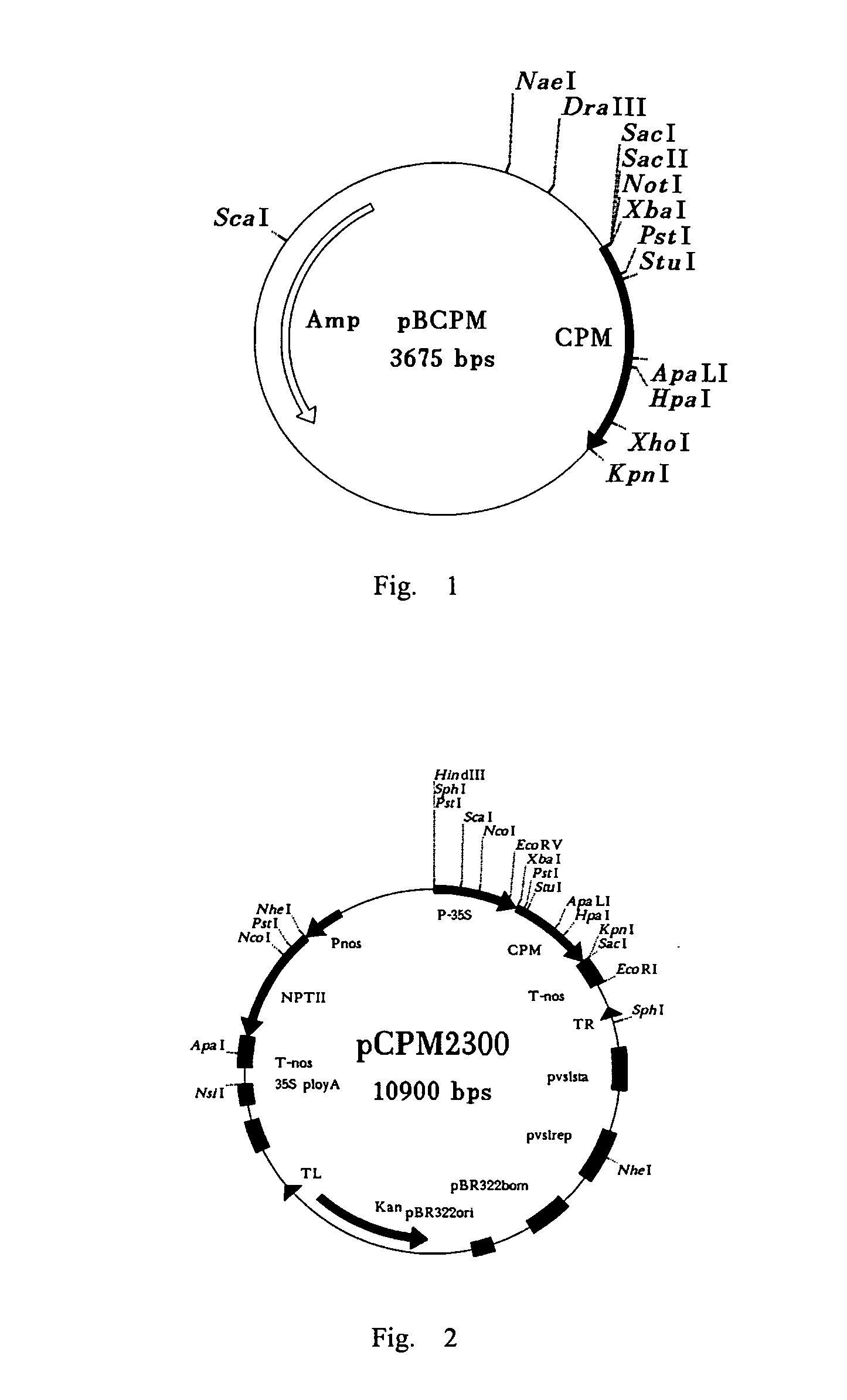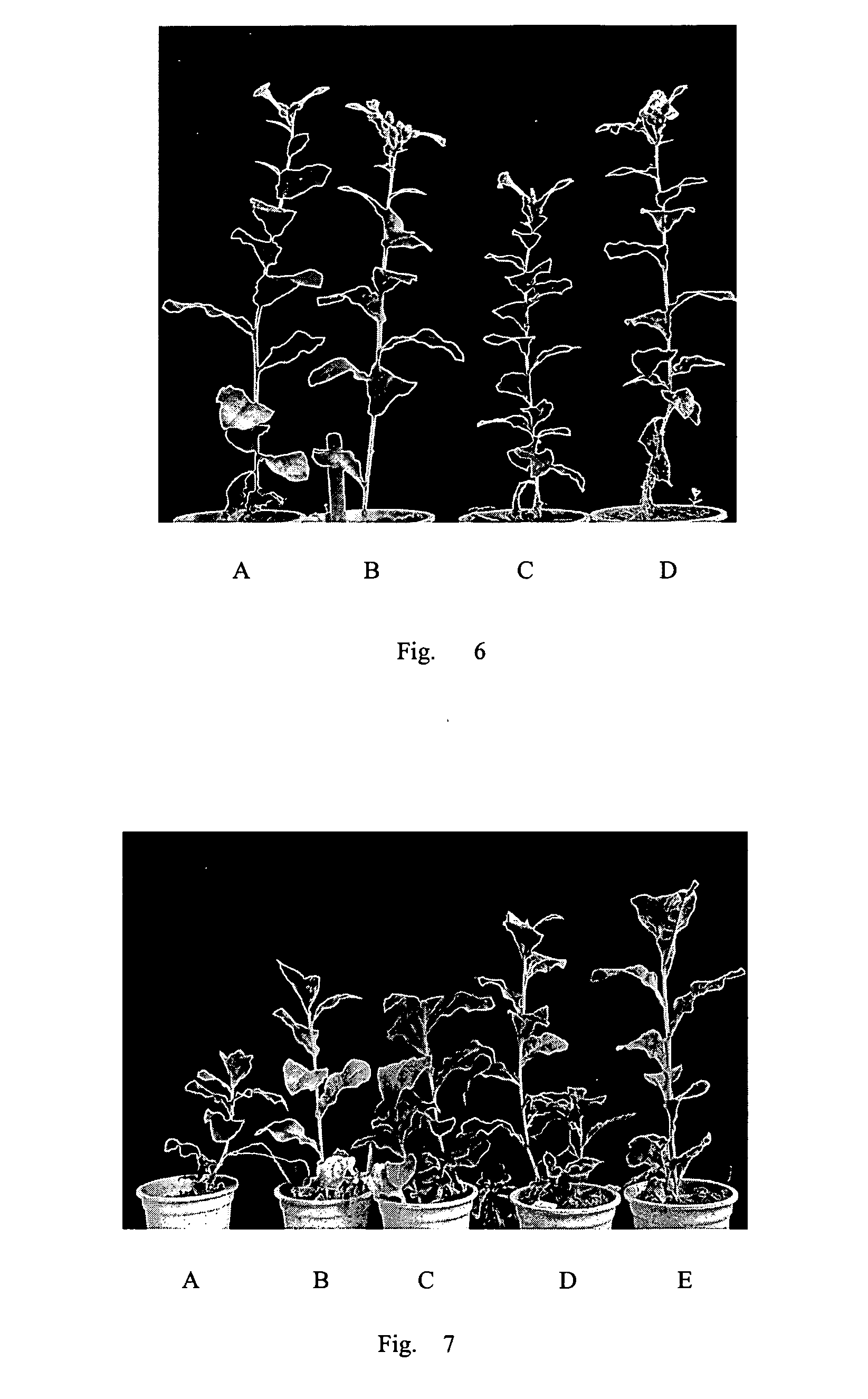Method for cultivating transgenic plants with high virus resistance and the use thereof
a transgenic plant and high antiviral property technology, applied in the field of transgenic plant breeding, can solve the problems of increasing the frequency of gene silencing, affecting agricultural production, and specific genes in a given host cannot be researched and exploited, so as to reduce the translation efficiency of lacz, increase the non-load rate or empty rate, and reduce the expression level
- Summary
- Abstract
- Description
- Claims
- Application Information
AI Technical Summary
Benefits of technology
Problems solved by technology
Method used
Image
Examples
example 1
Codon Modification of the Coat Protein Gene of the Potato Virus X (PVX)
[0029] Firstly, check the GenBank and find the values for the usage frequency of all the codons in the tobacco Nicotiana tabacum and of all the codons in the coat protein (CP) genes of the potato virus X (PVX). Then, identify the rare codons in tobacco (as shown in table 1).
TABLE 1Tobacco Nicotiana tabacum (T) and the CoatProtein Gene of Potato Virus (P)*FrequencyFrequencyFrequency(10−3)(10−3)(10−3)Amionof condonAminoof condonAminoof condonacidCondonusageacidCondonusageacidCondonusageTPTPTPArgCGA6.53.4LeuCUA9.214.7SerUCA17.613.4CGC4.04.4CUC10.218.1UCC10.410.3CGG3.73.0CUG10.314.9UCG5.24.0CGU7.62.5CUU23.911.2UCU20.29.5AGA15.414.8UUA12.511.1AGC10.016.4AGG12.215.9UUG21.415.2AGU13.112.0AlaGCU31.929.3GlyGGA24.018.1ValGUA11.310.3GCA22.828.8GGC11.6 14.1GUC11.416.1GCC12.727.2GGG10.5 10.3GUG16.519.7GCG5.87.9GGU23.3 11.7GUU26.912.1ThrACA17.329.6ProCCA20.420.7IleAUA14.413.1ACC9.920.1CCC6.811.9AUC13.824.6ACG4.57.0CCG4.88.6...
example 2
Construction of the Plant Expression Vector Containing PVX Coat Protein Gene
[0032] Place the PVX coat protein gene with mutation(s), i.e., the pBCPM gene, under the control of the 35S promoter of CaMV. (The specific sequence of the pBCPM gene is shown in FIG. 10. The single letter under each codon of the gene represents the corresponding amino acid. The bases to be mutated are indicated by boldface in the base sequences, and SEQ ID NO: 1 in the sequence list is the sequence to be mutated. Over the bases in boldface are the bases representing the new bases after the mutation, and SEQ ID NO: 2 in the sequence list is the mutated sequence. Each of the arrows represents one of the primers, as well as the direction of the specific primer. The shadow area indicates the recognition sequence of the restriction endonuclease that cuts the sequence at the right). Then, by using EcoR I and Hind III to digest pSPRCPM, the expression structure P35S-CPM-Tnos containing PVX coat protein gene is in...
example 3
Obtaining the Transgenic Tobacco Plants
[0033] The Agrobacterium tumefaciens LBA4404 containing the plant expression vectors pCPM2300 and pCPW2300, is inoculated into 20 ml of YEB liquid culture medium (containing 50 mg / L of each of Km and Rif, respectively). Incubate overnight at 28° C. in the dark. In the next day, 2%-4% of the culture is transferred and inoculated into YEB culture medium without antibiotic (containing 100 μM / L of acetyl syringone). Incubate for 3 hours under strong shaking. Measure the OD value and dilute to the corresponding concentration (the value of OD is at about 0.5). Take a sterile tobacco leaf and cut it into a leaf disc. Add the culture liquid of Agrobacterium tumefaciens having the corresponding concentration to immerse the leaf disc for 3 to 5 minutes. Then, the leaf disc is re-inoculated into the co-culture medium, and cultured for 2 to 3 days at 28° C. in the dark. Then, by strict screening with 75 mg / L Kan, obtain the resistant buds. The obtained re...
PUM
| Property | Measurement | Unit |
|---|---|---|
| constant temperature | aaaaa | aaaaa |
| temperature | aaaaa | aaaaa |
| concentration | aaaaa | aaaaa |
Abstract
Description
Claims
Application Information
 Login to View More
Login to View More - R&D
- Intellectual Property
- Life Sciences
- Materials
- Tech Scout
- Unparalleled Data Quality
- Higher Quality Content
- 60% Fewer Hallucinations
Browse by: Latest US Patents, China's latest patents, Technical Efficacy Thesaurus, Application Domain, Technology Topic, Popular Technical Reports.
© 2025 PatSnap. All rights reserved.Legal|Privacy policy|Modern Slavery Act Transparency Statement|Sitemap|About US| Contact US: help@patsnap.com



